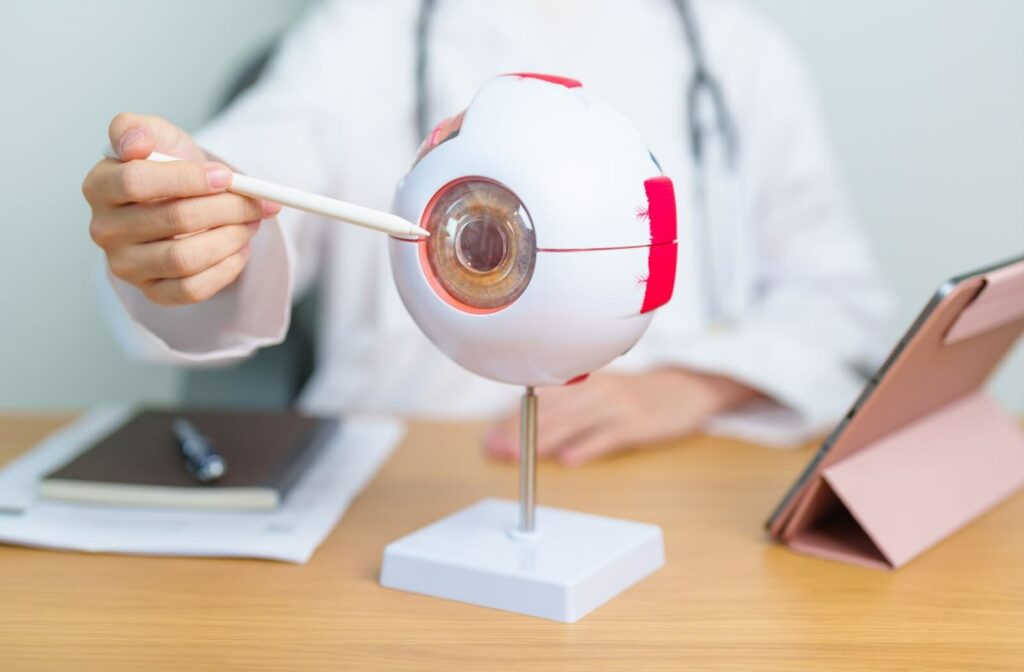Cataract surgery can bring new clarity to your world. However, many people wonder when it’s safe to get back behind the wheel after cataract surgery.
While many people can drive within a few days, you’ll need clearance from your ophthalmologist before you can safely operate a vehicle.
What to Expect Right After Your Procedure
Your eyes need some time to adjust after the surgery. For the first day or two, your main job is to rest and let your body begin the healing process.
How Your Eyes Heal
During the procedure, we replace the cloudy lens of the eye with one of several types of lens implants. This opening starts to close within the first 24 hours. We’ll give you a protective shield to wear, especially while you sleep, and we’ll provide eye drops to help your eye heal correctly.
Common Sensations After Surgery
It’s normal to notice a few temporary changes as your eye heals. These sensations often go away within a few days.
- Your vision might seem a little blurry or hazy at first.
- The white part of your eye may look red or bloodshot.
- You might feel a slight scratchiness—almost like an eyelash is in your eye.
When to Call Your Doctor
While some mild discomfort is part of the process, you should contact your ophthalmologist if you experience more significant symptoms, as certain issues may be considered eye emergencies. We want to hear from you if you have any concerns like:
- Sudden loss of vision
- Eye pain that doesn’t improve with time
- Seeing flashes of light
- Nausea or vomiting
The General Timeline for Your Recovery
Everyone’s recovery journey is a little different. However, there are some common milestones you can anticipate for getting back to your normal driving routine.
The First 24 to 48 Hours
You cannot drive on the day of your surgery. The medications you receive as part of the procedure can make you drowsy, and your vision will not be clear enough for driving. You will need to arrange for a friend or family member to take you home.
When Can You Go Out After Surgery?
You can typically resume light activities like walking around your home the day after your procedure. Most people feel ready to go out for short trips within a few days. You should wait for your doctor’s okay before you drive, even for short distances.
Your Follow-Up Visit with an Eye Doctor in Denver
You’ll have a follow-up appointment, usually the day after your surgery. At this visit, your eye doctor will check your vision and the health of your eye. If your sight meets the legal standard for driving and your eye is healing well, you may get clearance to drive.

Factors that Affect Your Drive Timeline
How quickly you return to driving depends on more than just the procedure itself. Several personal factors can play a part in your recovery speed.
The Vision in Your Other Eye
If you had surgery on one eye, your brain needs time to adjust to the difference in vision between your two eyes. Your depth perception might feel a little off until your second eye is treated.
How You Heal
Your age and overall health can influence how quickly you recover. Following all your post-operative instructions—like using your eye drops as prescribed and avoiding heavy lifting—is a key part of a smooth healing process.
What to Expect with a Night Drive
Driving at night is more demanding on your eyes than driving during the day. It’s common to notice some glare or halos around lights after surgery. Because of this, you’ll likely need to wait a little longer before you feel fully comfortable driving after dark.
Tips for a Safe First Drive
Once you get the green light from your doctor, it’s a good idea to ease back into driving. These simple tips can help you feel more confident on the road for the first time.
- Start Small & Simple: For your first drive, choose a short, familiar route during the day when traffic is light.
- Wear Sunglasses: Your eyes may be more sensitive to light, so a good pair of UV protection sunglasses can reduce glare and make driving more comfortable.
- Keep Your Eyes Lubricated: Use artificial tears if your eyes feel dry or irritated.
- Take a Break if You Need It: If you feel any eye strain, pull over when it’s safe to do so—don’t push yourself.
Other Daily Activities & Your Recovery
Driving isn’t the only activity you’ll be eager to resume. Here is a general guide for getting back to other common routines.
Light Exercise & Strenuous Activity
You can usually take walks the day after surgery. For more intense activities like running, yoga, or golf, it’s best to wait about one week. You should also avoid swimming for at least two weeks to reduce the risk of infection.
Screen Time & Read
You can watch TV, use a computer, or read within a few hours of your procedure. Your vision may be blurry at first as your brain adjusts to the new lens. The process of cataract diagnosis and treatment is designed to improve your vision for activities just like this. Take frequent breaks if your eyes start to feel tired.
Use of Eye Drops
Your doctor will prescribe antibiotic and anti-inflammatory eye drops to help with healing. You can also use lubricating drops—just be sure to use a new, unopened bottle. Remember to wait five minutes between different types of drops so they don’t wash each other out.
Keep Your Vision Clear
Your vision is our priority every step of the way. At Cherry Creek Eye Physicians & Surgeons, we’re here to answer your questions and support you through your recovery. If you’re ready to learn more about improving your vision, schedule a consultation with our team today.


